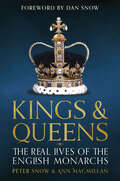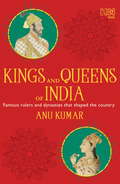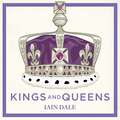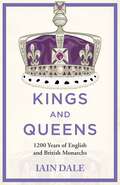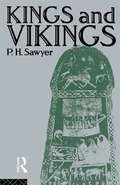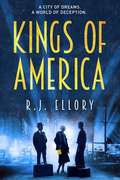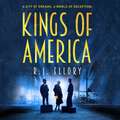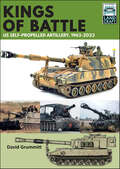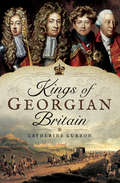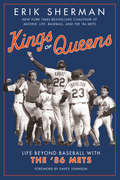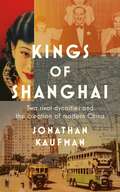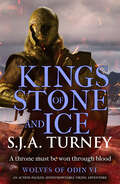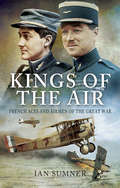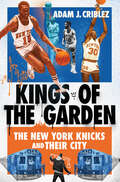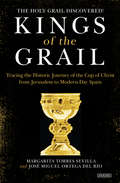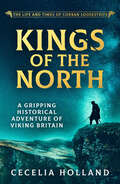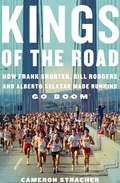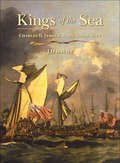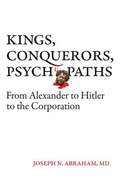- Table View
- List View
Kings and Queens of England: The Real Lives Of The English Monarchs
by Peter SnowHistorians and broadcasters Peter Snow and Ann MacMillan tell the real stories of the most powerful men and women in British history.Updated for the 2023 coronation, Kings & Queens explores the lives, loves, triumphs and disasters of a monarchy that is the envy of the world. Snow and MacMillan offer a unique insight into those born to rule, whether villains or heroes – from cruel King John and warrior-king Edward III, to our newest monarch, King Charles III.This is the story of modern civilization through the lens of those who have ruled.
Kings and Queens of England: The Real Lives Of The English Monarchs
by Peter SnowHistorians and broadcasters Peter Snow and Ann MacMillan tell the real stories of the most powerful men and women in British history.Updated for the 2023 coronation, Kings & Queens explores the lives, loves, triumphs and disasters of a monarchy that is the envy of the world. Snow and MacMillan offer a unique insight into those born to rule, whether villains or heroes – from cruel King John and warrior-king Edward III, to our newest monarch, King Charles III.This is the story of modern civilization through the lens of those who have ruled.
Kings and Queens of India: All about famous rulers and dynasties that shaped the country
by Anu KumarThe incredible stories of the most powerful and ambitious rulers in Indian history.They ruled vast and influential kingdoms across our country. They laid down laws and systems of administration. They fought wars that had far-reaching impact, and negotiated peaceful times that nurtured the arts and the sciences. They made decisions that, whether right or wrong, shaped events and moulded our culture. They were the kings and queens who played lead roles in the spectacular drama of India’s past. From Kanishka, Harshavardhana, Razia, Akbar and Ranjit Singh in the north to Narasimhavarman, Rajaraja Chola, Krishnadevaraya, Mangammal, Marthanda Varma and Tipu Sultan in the south, and from Gautamiputra Satakarni, Amoghavarsha, Mihira Bhoja and Shivaji in the west to Bimbisara, Chandragupta Maurya, Ashoka, Gopala I and the Bhaumakara queens in the east – this book tells the riveting stories of close to 50 important rulers whose actions left a mark on the history of India. Read about their lives and the times they lived in, what they achieved and what they failed at – and why they are still remembered – in Kings and Queens of India. Packed with intriguing facts, this comprehensive volume is the perfect introduction to India’s rich and utterly fascinating royal heritage.*Dynasties Download: Important dynasties and their significance*Impact Summary: Why these monarchs matter in history*Top Trivia: Fun facts about Indian royals
Kings and Queens: 1200 Years of English and British Monarchs
by Iain DaleAn essay on every individual who sat on the British and English throne, compiled and edited by Iain Dale.'We all know about Queen Victoria, Edward VIII and Queen Elizabeth II, but how much do we really know about other monarchs? Yes, we know William the Conqueror beat King Harold at the Battle of Hastings. We know George III was mad, but what else do we know about his 60 year long reign? We know Henry VIII famously had six wives, but do we know much more about him, other than he was very fat?'The British monarchy is one of the oldest in the world - dating so far back that even its origins are the subject of debate. Was William the Conqueror the first king of England, or was it Alfred the Great? In this third instalment of the series that began with The Prime Ministers and The Presidents, Iain Dale charts this long history of the English and British monarchy, with 64 essays by journalists, historians and politicians on every individual to have sat on the throne, as well as some who didn't.From Alfred the Great to Charles III, each essay examines the monarch, their role and what they tell us about British history. Why has the British monarchy, unlike so many others, endured? Kings and Queens will attempt to answer this question, and many others, providing valuable insight into British history and how Britain is ruled today.(P)2023 Hodder & Stoughton Limited
Kings and Queens: 1200 Years of English and British Monarchs
by Iain Dale'We all know about Queen Victoria, Edward VIII and Queen Elizabeth II, but how much do we really know about other monarchs? Yes, we know William the Conqueror beat King Harold at the Battle of Hastings. We know George III was mad, but what else do we know about his 60 year long reign? We know Henry VIII famously had six wives, but do we know much more about him, other than he was very fat?'The British monarchy is one of the oldest in the world - dating so far back that even its origins are the subject of debate. Was William the Conqueror the first king of England, or was it Alfred the Great? In this third instalment of the series that began with The Prime Ministers and The Presidents, Iain Dale charts this long history of the English and British monarchy, with 64 essays by journalists, historians and politicians on every individual to have sat on the throne, as well as some who didn't.From Alfred the Great to Charles III, each essay examines the monarch, their role and what they tell us about British history. Why has the British monarchy, unlike so many others, endured? Kings and Queens will attempt to answer this question, and many others, providing valuable insight into British history and how Britain is ruled today.
Kings and Queens: 1200 Years of English and British Monarchs
by Iain Dale'We all know about Queen Victoria, Edward VIII and Queen Elizabeth II, but how much do we really know about other monarchs? Yes, we know William the Conqueror beat King Harold at the Battle of Hastings. We know George III was mad, but what else do we know about his 60 year long reign? We know Henry VIII famously had six wives, but do we know much more about him, other than he was very fat?'The British monarchy is one of the oldest in the world - dating so far back that even its origins are the subject of debate. Was William the Conqueror the first king of England, or was it Alfred the Great? In this third instalment of the series that began with The Prime Ministers and The Presidents, Iain Dale charts this long history of the English and British monarchy, with 64 essays by journalists, historians and politicians on every individual to have sat on the throne, as well as some who didn't.From Alfred the Great to Charles III, each essay examines the monarch, their role and what they tell us about British history. Why has the British monarchy, unlike so many others, endured? Kings and Queens will attempt to answer this question, and many others, providing valuable insight into British history and how Britain is ruled today.
Kings and Vikings: Scandinavia and Europe AD 700–1100
by P.H. SawyerProfessor Sawyer offers some new interpretations of the development of Scandinavian society and history of the Christian conversion.
Kings for Three Days: The Play of Race and Gender in an Afro-Ecuadorian Festival
by Jean Muteba RahierWith its rich mix of cultures, European influences, colonial tensions, and migration from bordering nations, Ecuador has long drawn the interest of ethnographers, historians, and political scientists. In this book, Jean Muteba Rahier delivers a highly detailed, thought-provoking examination of the racial, sexual, and social complexities of Afro-Ecuadorian culture, as revealed through the annual Festival of the Kings. During the Festival, the people of various villages and towns of Esmeraldas--Ecuador's province most associated with blackness--engage in celebratory and parodic portrayals, often donning masks, cross-dressing, and disguising themselves as blacks, indigenous people, and whites, in an obvious critique of local, provincial, and national white, white-mestizo, and light-mulatto elites. Rahier shows that this festival, as performed in different locations, reveals each time a specific location's perspective on the larger struggles over identity, class, and gender relations in the racial-spacial order of Esmeraldas, and of the Ecuadorian nation in general.
Kings of America
by R.J. ElloryIn America, kings are not born, they are made.Danny McCabe isn't his real name. America certainly isn't his real home.But now Danny finds himself fleeing Ireland for the bright lights of 1930s Hollywood with two virtual strangers, Nicky Mariani and his beautiful sister, Lucia. As Lucia pursues her dream of stardom, Nicky finds his calling in the violent underbelly of the city of dreams. Torn between his love for Lucia and his desperate fear for their safety, Danny is drawn into a chain of events that will pit brother against sister, friend against friend, and lover against lover.
Kings of America
by R.J. ElloryDanny McCabe is on the run. He committed a terrible crime. And he'd do it again.A promising boxer back in his native Ireland, he had to start over with a new life and a new home, halfway across the world in up-and-coming New York City.A chance encounter tangles his life up with fellow immigrants Nicky and Lucia Mariani. The siblings came to the land of opportunity with high hopes and little else. As Danny scrapes by, Lucia dreams of Hollywood stardom, while Nicky's reckless ambition measures success only in money and power.They are the only family Danny has. He would do anything for them. But every family has its secrets -- even from each other . . .This is a sweeping story set over three decades, from Europe to America, from the slums and tenements of New York to the glitz and glamour of the Hollywood Hills, from the dark heart of the American Dream to an impossible choice . . .
Kings of Battle US Self-Propelled Howitzers, 1981–2022 (LandCraft)
by David GrummittDelves into the history and use of M107, M109, and M110 howitzers, while also offering comprehensive information on modeling kits for enthusiasts. It is for good reason that artillery is known as the ‘king of battle’. In World War II the United States made good use of self-propelled howitzers, including those based on the chassis of the M4 Sherman tank. After 1945 the US developed both light and medium self-propelled howitzers, based on the M24 Chaffee, M41 Walker Bulldog and Sherman chassis. The first designs were plagued with problems and self-propelled artillery played only a minor role in the Korean War. By the mid 1960s, however, the M107 175mm, M109 155mm and M110 203mms self-propelled howitzers had entered service, and they proved their effectiveness during the Vietnam War. The M107 was relatively short-lived in US service, being retired in the late 1970s, but it played an important role with the Israel defense Forces. The M109 served with the US Army, as well as in many NATO armies and elsewhere, and saw action in the Middle East, in the Balkans, during the liberation of Kuwait, and in the invasion of Iraq. The M109 has now been in service for some sixty years and remains, in the guise of the M109A7, the current self-propelled howitzer of the US Army. The larger M110 203mm self-propelled howitzer similarly saw widespread service before it was retired in the early 1990s. Despite the emergence of rocket artillery, such as the Multiple Launch Rocket System, the self-propelled howitzer will remain one of the principal weapons systems of US military in the decades to come. The M107, M109 and M110 have proved popular subjects among modellers with a variety of kits available from the major manufacturers. As well as describing in detail the technical development and operational history of these guns, this book gives a full account of the wide range of modelling kits and accessories available in all the popular scales. Included is a modelling gallery which covers a range of variants and a section of large-scale color profiles which provide both information and inspiration for modellers and military enthusiasts alike.
Kings of Georgian Britain
by Catherine CurzonThis royal historian&’s &“lively study of the four Georges who sat on the English throne for over a century is a joy&” (Jane Austen&’s Regency World). For over one hundred years of turmoil, upheaval, and scandal, Great Britain was a Georgian land. From the day the German-speaking George I stepped off the boat from Hanover to the night that George IV, bloated and diseased, breathed his last at Windsor, the four kings had presided over a changing nation. Kings of Georgian Britain offers a fresh perspective on the lives of the four Georges and the events that shaped their characters and reigns. From love affairs to family feuds, political wrangling, and beyond, it is a chance to peer behind the pomp and follow these iconic figures from cradle to grave. After all, being a king isn&’t always about grand parties and jaw-dropping jewels, and sometimes following in a father&’s footsteps can be the hardest job around. Take a step back in time and meet the wives, mistresses, friends, and foes of these remarkable kings who shaped the nation, and find out what really went on behind closed palace doors. Whether dodging assassins, marrying for money, digging up their ancestors, or sparking domestic disputes that echoed down the generations, the kings of Georgian Britain were never short on drama. &“[A] chronological series of amusing anecdotes. [Curzon is] often whimsical, has a good sense of pace and you can imagine her stifling a smirk while writing this unusual biography.&” —History of Royals
Kings of Queens: Life Beyond Baseball with the '86 Mets
by Erik ShermanIn 1986, the bad guys of baseball won the World Series. Now, Erik Sherman, the New York Times bestselling coauthor of Mookie, profiles key players from that infamous Mets team, revealing never-before-exposed details about their lives after that championship year...as well as a look back at the magical season itself. Darryl Strawberry, Doc Gooden, Keith Hernandez, Lenny Dykstra, Mookie Wilson, Howard Johnson, Doug Sisk, Rafael Santana, Bobby Ojeda, Wally Backman, Kevin Mitchell, Ed Hearn, Danny Heep, and the late Gary Carter were all known for their heroics on the field. For some of them--known as the "Scum Bunch"--their debauchery off the field was even more awe-inspiring. But when that golden season ended, so did their aura of invincibility. Some faced battles with addiction, some were traded, and others struggled just to keep their lives together. Through interviews with these legendary players, Erik Sherman offers fans a new perspective on a team that will forever be remembered in sports history.INCLUDES PHOTOSFrom the Hardcover edition.
Kings of Shanghai: The Rival Jewish Dynasties That Helped Create Modern China
by Jonathan Kaufman'A masterpiece of research, The Last Kings of Shanghai is a vivid and fascinating story of wealth, family intrigue, and political strategy on the world stage from colonialism to communism to globalized capitalism' Susannah Heschel, Eli Black Professor of Jewish Studies, Dartmouth CollegeAn epic, multigenerational story of two rival dynasties who flourished in Shanghai and Hong Kong as twentieth-century China surged into the modern eraShanghai, 1936. The Cathay Hotel, located on the city's famous waterfront, is one of the most glamorous in the world. Built by Victor Sassoon - billionaire playboy and scion of the Sassoon dynasty - the hotel hosts a who's who of global celebrities: Noel Coward has written a draft of Private Lives in his suite, Charlie Chaplin entertained his wife-to-be, and the American socialite Wallis Simpson reportedly posed for 'glamour' photographs. A few miles away, Mao and the nascent Communist party have been plotting revolution before being forced to flee the city.By the 1930s, the Sassoons had been doing business in China for a century, rivaled in wealth and influence by only one other dynasty - the Kadoories. These two Jewish families, both originally from Baghdad, stood astride Chinese business and politics for more than one hundred and seventy five years, profiting from the Opium Wars; surviving Japanese occupation; courting Chiang Kai-shek; and nearly losing everything as the Communists swept into power. In Kings of Shanghai, Jonathan Kaufman tells the remarkable history of how these families ignited an economic boom and opened China to the world, but remained blind to the country's deep inequality and to the political turmoil on their doorsteps. In a story stretching from Baghdad to Hong Kong to Shanghai to London, Kaufman enters the lives and minds of these ambitious men and women to forge a tale of opium smuggling, family rivalry, political intrigue and survival.
Kings of Stone and Ice: An action-packed, unputdownable Viking adventure (Wolves of Odin)
by S.J.A. TurneyA thrilling quest for the throne of Norway and, at long last, revenge… After years of voyaging around the world, the Wolves of Odin are going home. Far from the green crew led by an unblooded, wily lad that departed Sigtun, they return a renowned, feared war-band, led by Jarl Halfdan Loki-Born. They have come back to hunt down the last man responsible for the death of Halfdan’s father, the wicked Christian priest Hjalmvigi. But upon sailing into harbour, they see a familiar sight at the dock: their first ship, Sea Wolf. Its thief, the legendary Harald Hardrada – last seen escaping Constantinople with a hold full of treasure – can’t be far away. He isn’t. They quickly find him planning his next grand scheme: seizing the throne of Norway from its king, Magnus. And he needs the help of a renowned, feared war-band… A gripping Viking adventure packed with political intrigues and battles, perfect for fans of Giles Kristian.
Kings of the Air: French Aces and Airmen of the Great War
by Ian Sumner&“Simply superb! . . . easily the best book (in English) available on the French Air Service . . . The book is a gem.&”—The Aerodrome In comparison to their British and German counterparts, the French airmen of the Great War are not well known. Yet their aerial exploits were just as remarkable, and their contribution to the war effort on the Western Front was equally important. That is why Ian Sumner&’s vivid history of the men of the French air force during the war is of such value. He tells their story using the words of the pioneering pilots and observers themselves, drawn from memoirs, diaries, letters, and contemporary newspapers, magazines and official documents. The recollections of the airmen give an authentic portrait of their role and their wartime careers. They cover recruitment and training, reconnaissance and artillery spotting, aerial combat, ground strafing and bombing, and squadron life. They also highlight the technical and tactical innovations made during those hectic years, as well as revealing the airmen&’s attitude to the enemy—and their thoughts about the ever-present threat of injury and death. &“No stone unturned, well researched and well written, Kings of the Air should become the &‘go to&’ title for information about the French contribution to the air war of the Great War.&”—The Past in Review &“The narrative provides a complete overview of developments in technology, service organization, naval aviation and the principle missions of the French Air Service, all laced with first-person accounts . . . Kings of the Air should be in the collection of any student of the first air war.&”—Over the Front
Kings of the Air: French Aces and Airmen of the Great War
by Ian Sumner&“Simply superb! . . . easily the best book (in English) available on the French Air Service . . . The book is a gem.&”—The Aerodrome In comparison to their British and German counterparts, the French airmen of the Great War are not well known. Yet their aerial exploits were just as remarkable, and their contribution to the war effort on the Western Front was equally important. That is why Ian Sumner&’s vivid history of the men of the French air force during the war is of such value. He tells their story using the words of the pioneering pilots and observers themselves, drawn from memoirs, diaries, letters, and contemporary newspapers, magazines and official documents. The recollections of the airmen give an authentic portrait of their role and their wartime careers. They cover recruitment and training, reconnaissance and artillery spotting, aerial combat, ground strafing and bombing, and squadron life. They also highlight the technical and tactical innovations made during those hectic years, as well as revealing the airmen&’s attitude to the enemy—and their thoughts about the ever-present threat of injury and death. &“No stone unturned, well researched and well written, Kings of the Air should become the &‘go to&’ title for information about the French contribution to the air war of the Great War.&”—The Past in Review &“The narrative provides a complete overview of developments in technology, service organization, naval aviation and the principle missions of the French Air Service, all laced with first-person accounts . . . Kings of the Air should be in the collection of any student of the first air war.&”—Over the Front
Kings of the Garden: The New York Knicks and Their City
by Adam J. CriblezIn Kings of the Garden, Adam J. Criblez traces the fall and rise of the New York Knicks between the 1973, the year they won their last NBA championship, and 1985, when the organization drafted Patrick Ewing and gave their fans hope after a decade of frustrations. During these years, the teams led by Walt Frazier, Earl Monroe, Bob McAdoo, Spencer Haywood, and Bernard King never achieved tremendous on-court success, and their struggles mirrored those facing New York City over the same span. In the mid-seventies, as the Knicks lost more games than they won and played before smaller and smaller crowds, the city they represented was on the brink of bankruptcy, while urban disinvestment, growing income inequality, and street gangs created a feeling of urban despair. Kings of the Garden details how the Knicks' fortunes and those of New York City were inextricably linked. As the team's Black superstars enjoyed national fame, Black musicians, DJs, and B-boys in the South Bronx were creating a new culture expression—hip-hop—that like the NBA would become a global phenomenon. Criblez's fascinating account of the era shows that even though the team's efforts to build a dynasty ultimately failed, the Knicks, like the city they played in, scrappily and spectacularly symbolized all that was right—and wrong—with the NBA and the nation during this turbulent, creative, and momentous time.
Kings of the Grail: Discovering the True Location of the Cup of Christ in Modern-Day Spain
by Margarita Torres Sevilla José Miguel Ortega del RioThe explosive new book that reveals the true location of the Holy Grail--hidden in plain sight for centuries Recently discovered parchments in the Egyptian University of Al-Azhar have finally made it possible to identify the location where the Holy Grail has been kept for the last 1,000 years. Their discovery led Margarita Torres Sevilla and José Miguel Ortega del Río on a three-year investigation as they traced the Grail's journey across the globe and discovered its final resting place in the Basilica of San Isidoro in León, Spain. Translated by Rosie Marteau, this is the definitive guide to one of history's most sought-after treasures, the origin and object of both Arthurian myth and Christian legend, offering meticulously researched information to support an extraordinary discovery. Kings of the Grail presents the new, definitive historical and scientific facts that have come to light, unravelling the mystery that has surrounded the Holy Grail and taking the reader on a compelling and thought-provoking journey back through time.
Kings of the Grail: Discovering the True Location of the Cup of Christ in Modern-Day Spain
by Margarita Torres Sevilla José Miguel Ortega del RioThe explosive new book that reveals the true location of the Holy Grail—hidden in plain sight for centuries Recently discovered parchments in the Egyptian University of Al-Azhar have finally made it possible to identify the location where the Holy Grail has been kept for the last 1,000 years. Their discovery led Margarita Torres Sevilla and José Miguel Ortega del Río on a three-year investigation as they traced the Grail’s journey across the globe and discovered its final resting place in the Basilica of San Isidoro in León, Spain. Translated by Rosie Marteau, this is the definitive guide to one of history’s most sought-after treasures, the origin and object of both Arthurian myth and Christian legend, offering meticulously researched information to support an extraordinary discovery. Kings of the Grail presents the new, definitive historical and scientific facts that have come to light, unravelling the mystery that has surrounded the Holy Grail and taking the reader on a compelling and thought-provoking journey back through time.
Kings of the Grail: Tracing the Historic Journey of the Cup of Christ from Jerusalem to Modern-Day Spain
by Margarita Torres Sevilla“Stand down, Indiana Jones: these two historians say the holy grail has been discovered . . . A ride rich in historical detail” (Publishers Weekly). Recently discovered parchments in the Egyptian University of Al-Azhar have finally made it possible to identify where the Holy Grail has been kept for the past one thousand years. Their discovery led Margarita Torres Sevilla and José Miguel Ortega del Río on a three-year investigation as they traced the Grail’s journey across the globe and discovered its final resting place in the Basilica of San Isidoro in León, Spain. Translated by Rosie Marteau, this is the definitive guide to one of history’s most sought-after treasures, the object of both Arthurian myth and Christian legend. Kings of the Grail presents new historical and scientific facts that have come to light, unraveling the mystery that has surrounded the Holy Grail and taking the reader on a compelling and thought-provoking journey back through time. “The writers make a convincing case . . . This book is a fascinating look at a mystery which has caught the Western imagination via books, poems and movies.” —The Historical Novels Review “An academic exposé on the famed cup of Christ. Torres Sevilla and Ortega del Río claim to have proven the identity of the true grail, the cup with which Jesus Christ and his Apostles shared wine at the Last Supper . . . [An] intriguing glimpse at one of Christianity’s great treasures.” —Kirkus Reviews
Kings of the North (The Life and Times of Corban Loosestrife)
by Cecelia HollandFrom &“a true master,&” a historical fantasy featuring an Irish adventurer caught up in the epic struggle for the throne of England (Kirkus Reviews). After fleeing Constantinople and the wrath of the Emperor, Raef Corbanson has washed up with his companions on the coast of Normandy. His former patron Gunnhild is dead, and Raef is commanded to return to his father&’s hall in Jorvik, in England. Duke Richard of Normandy has sent his sister Emma to be wife to Ethelred of Wessex, the King of England. But other powers have designs on the island kingdom; Sweyn Forkbeard, king of Denmark and Raef&’s old shipmate, would be King of England, too. And Ethelred has other sons, older sons from his first marriage. Raef cannot escape this web of power; he owes a debt to Emma and her brother for aiding him. He owes fealty to Ethelred, for Jorvik is part of England, and Raef intends to rule the city as his father once did. And he owes an older, stronger, loyalty to Sweyn, for they are kin. &“Holland&’s battle scenes are brilliantly, viscerally detailed, and she&’s even better in quieter scenes that provide illuminating contrasts . . . If you love history, do not under any circumstances overlook or underestimate Cecelia Holland.&” —Kirkus Reviews
Kings of the Road: How Frank Shorter, Bill Rodgers, and Alberto Salazar Made Running Go Boom
by Cameron StracherA &“lively, informative history&” of distance running&’s 1970s heyday—including the famous Falmouth Road Race—written &“with a true fan&’s contagious enthusiasm&” (Newsweek). It was 1978. Jimmy Carter was president; gas prices were soaring; and Americans were hunkering down to weather the economic crisis. But Jim Fixx&’s The Complete Book of Running was a bestseller. Frank Shorter&’s gold medal in the 1972 Olympic marathon had put distance running on the minds of many Americans. The odd activity of &“jogging&” became &“running,&” and America was in love. That summer, a junior from the University of Oregon named Alberto Salazar went up against Shorter and Boston Marathon champion Bill Rodgers at the Falmouth Road Race. Though he lost to Rodgers&’s record-setting 32:21, the competition set the stage for an epic rivalry among the three greats. Each pushed the others to succeed and, in turn, inspired a nation of couch potatoes to put down the remote and lace up their sneakers. &“[A] lively, informative history.&” — Newsweek/The Daily Beast &“Essential reading for runners both competitive and casual.&” —Kirkus Reviews &“Kings of the Road is about marathon legends. It&’s about running Fast. It&’s about Will. It&’s about the Real. It&’s about drama of the finest kind.&” —Bernd Heinrich, author of Why We Run and Racing the Antelope &“A rollicking, informed account of . . . how distance running helped define a generation.&” —John Brant, author of Duel in the Sun and coauthor with Alberto Salazar of 14 Minutes
Kings of the Sea: Charles II, James II & the Royal Navy
by J. D. DaviesIt has always been widely accepted that the Stuart kings, Charles II and James II, had an interest in the navy and more generally in the sea. Their enthusiastic delight in sailing, for instance, is often cited as marking the establishment of yachting in England. The major naval developments in their reigns on the other hand developments that effectively turned the Royal Navy into a permanent, professional fighting force for the first time have traditionally been attributed to Samuel Pepys.This new book, based on a wide range of new and previously neglected evidence, presents a provocative new theory: that the creation of the proper Royal Navy was in fact due principally to the Stuart brothers, particularly Charles II, who is presented here, not as the lazy monarch neglectful of the detail of government, but as a king with an acute and detailed interest in naval affairs. The author also demonstrates that Charles Stuart predecessors were far more directly involved in naval matters than has usually been allowed, and proves that Charles and James command of ship design and other technical matters went well beyond the bounds of dilettante enthusiasm.It is shown how Charles in particular, intervened in ship design discussions at a highly technical level; how the brothers were principally responsible for the major reforms that established a permanent naval profession; and how they personally sponsored important expeditions and projects such as Greenvile Collins survey of British waters. The book also reassesses James IIs record as a fighting admiral.It is a fascinating journey into the world of the Stuart navy and shows how the Kings of the Sea were absolutely central to the development of its ships, their deployment and the officer corps which commanded them; it offers a major reassessment of that dynastys involvement in naval warfare.
Kings, Conquerors, Psychopaths: From Alexander To Hitler To The Corporation
by Joseph AbrahamRight wing populists increasingly draw attention around the globe, but the attention is misdirected. The real problem is not the authoritarian leader, but the blinkered supporters who unquestioningly follow him. Without them, the despot is irrelevant. Why do we attach ourselves to demagogues and mountebanks? Why do we defend even their most obvious hypocrisies and lies? The answer lies in the roots of civilization. Despite our romantic traditions, monarchs were never wise, just, nor generous. Even the briefest review of history shows that, without exception, kings were the most vicious psychopaths, narcissists, and sadists who ever lived. And the only path for survival in the ancient world required unquestioningly obeying— and blindly believing— anything the king said.
